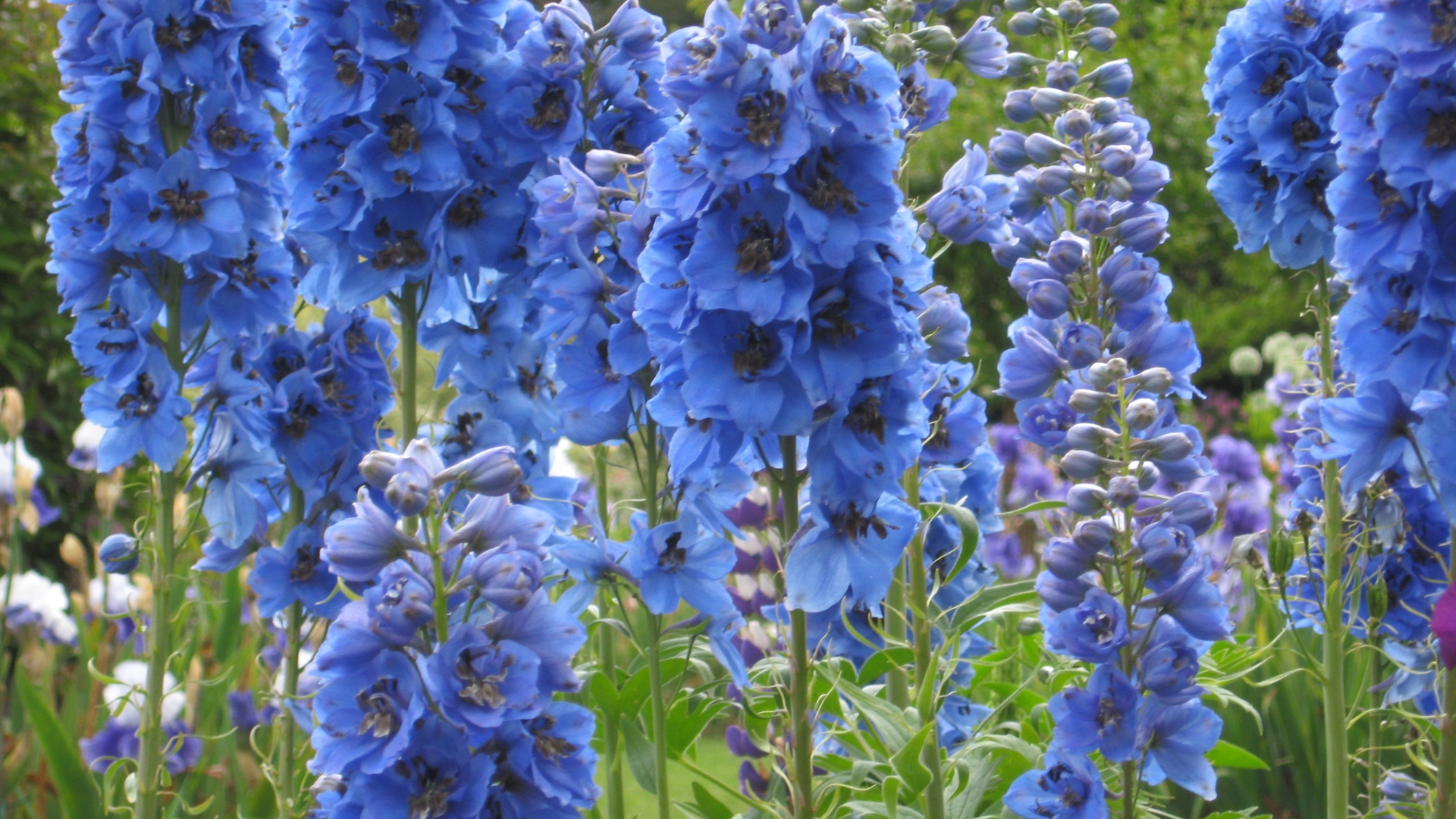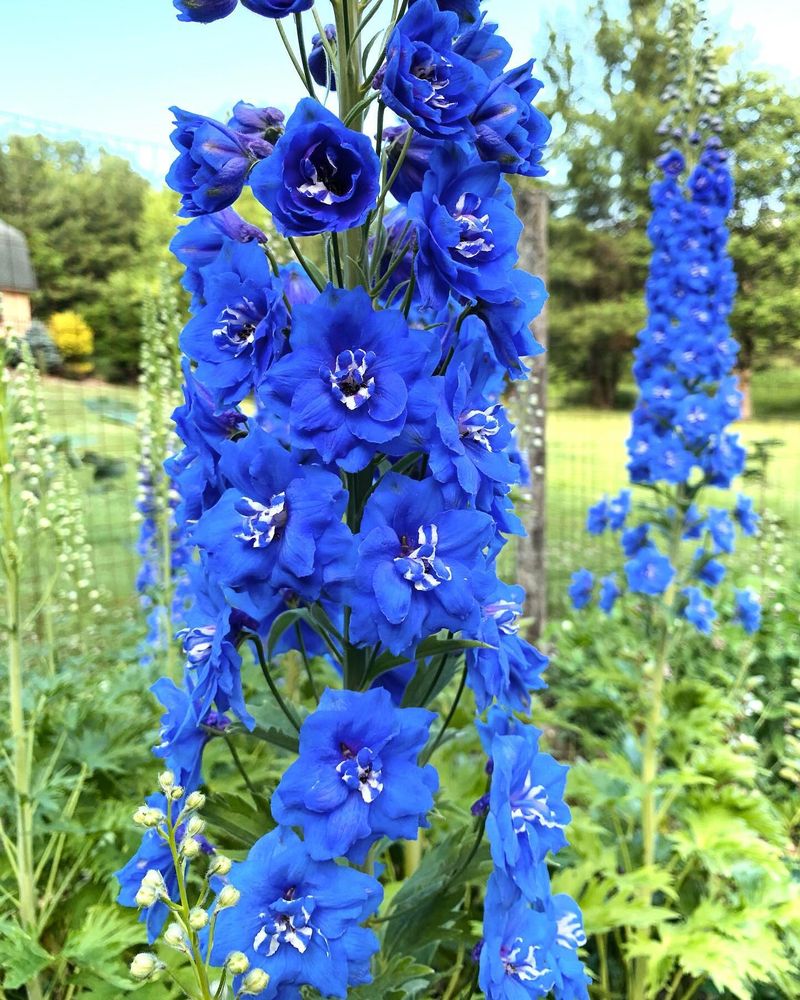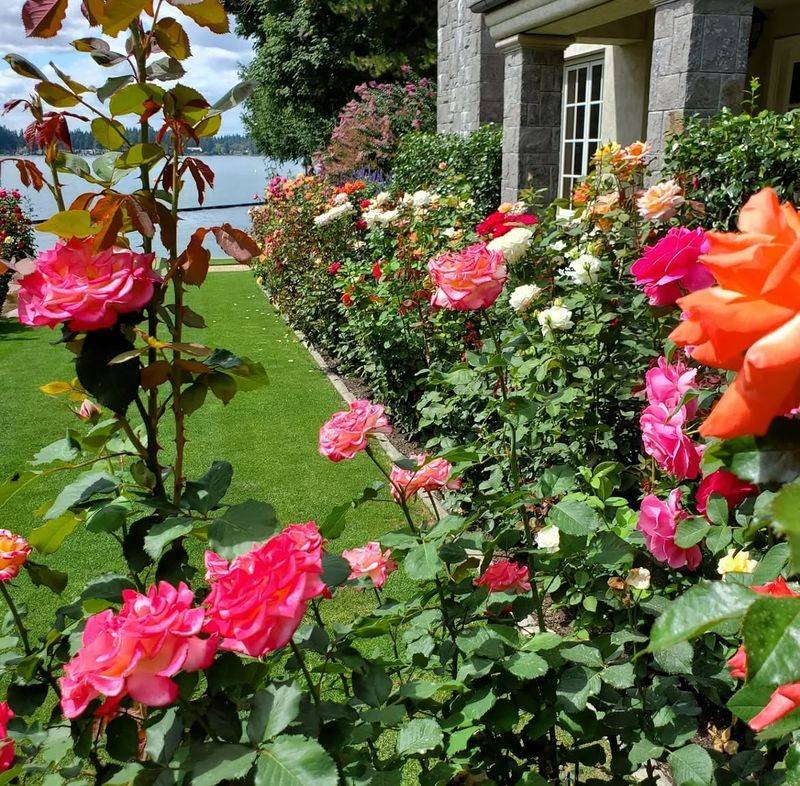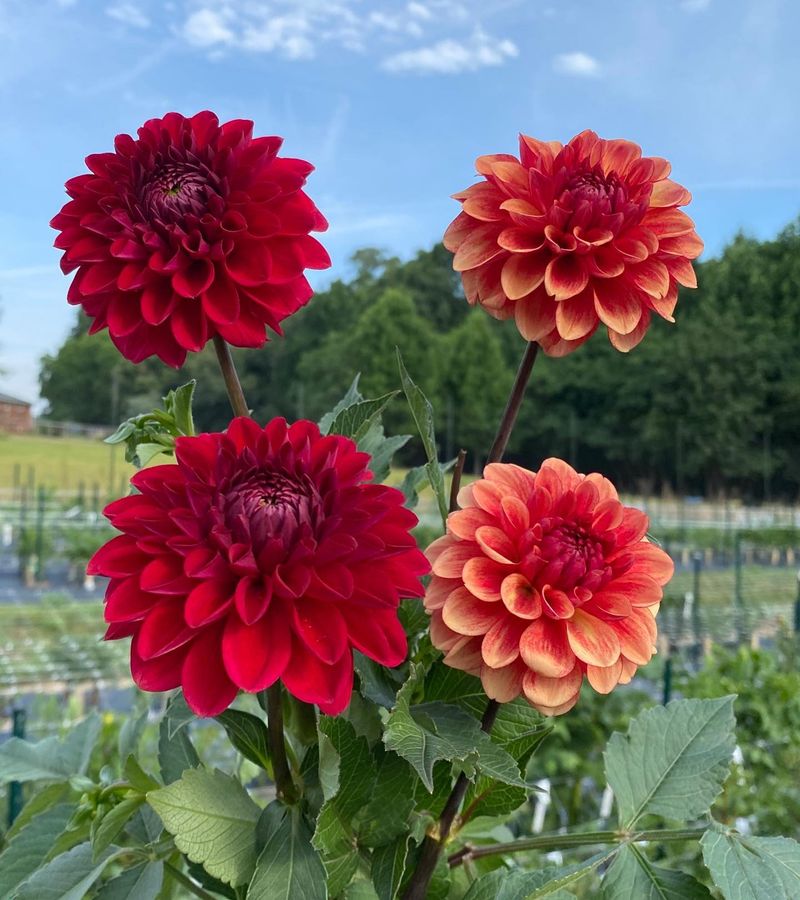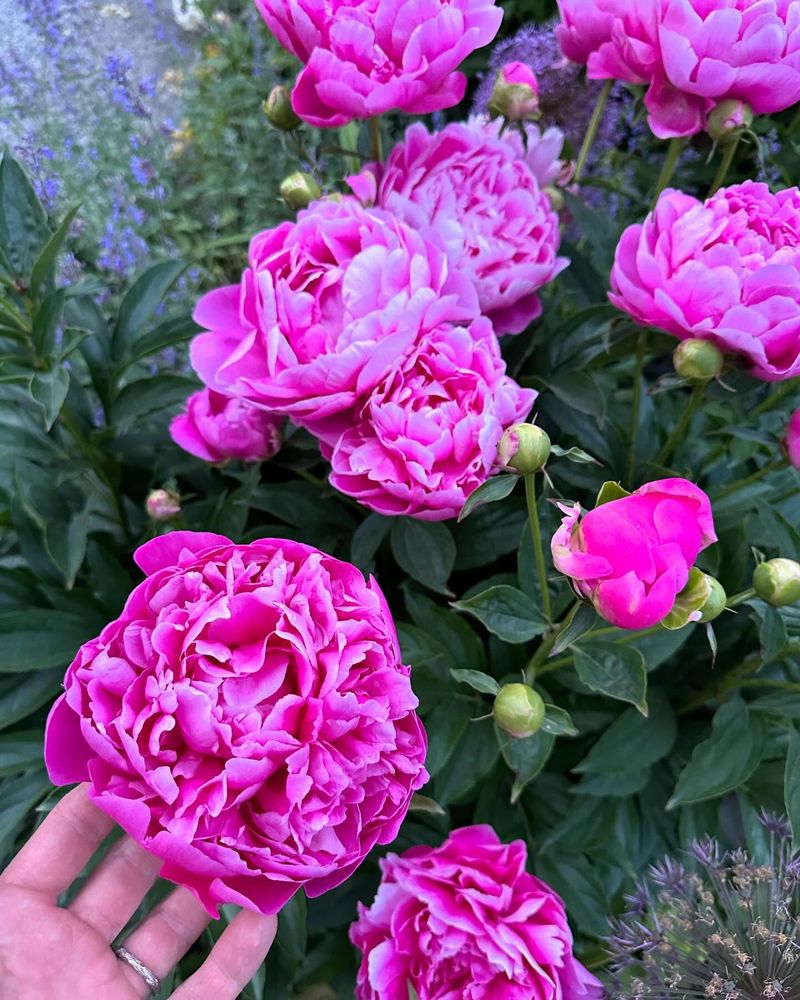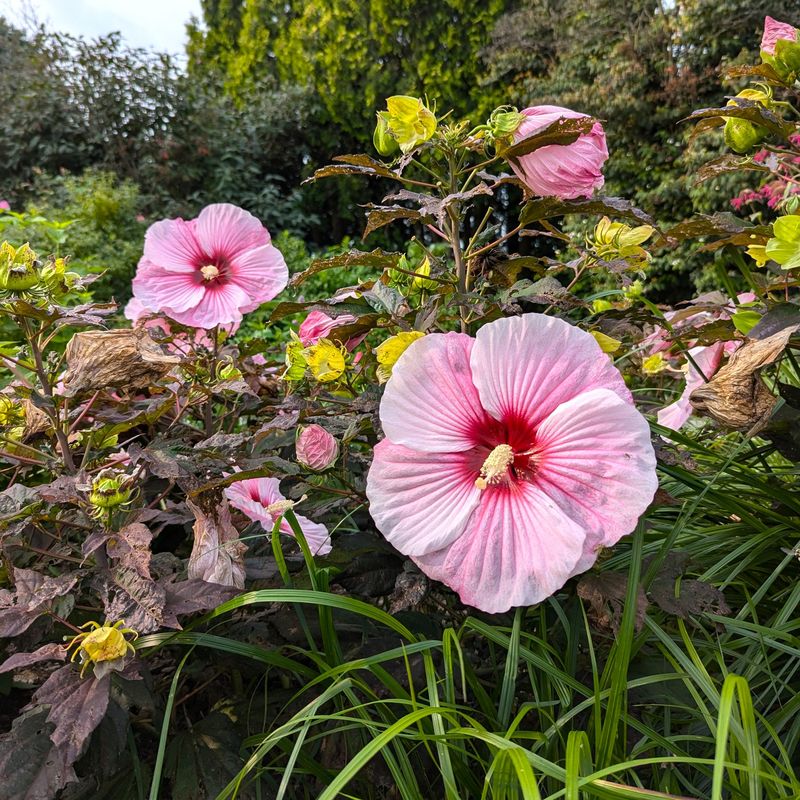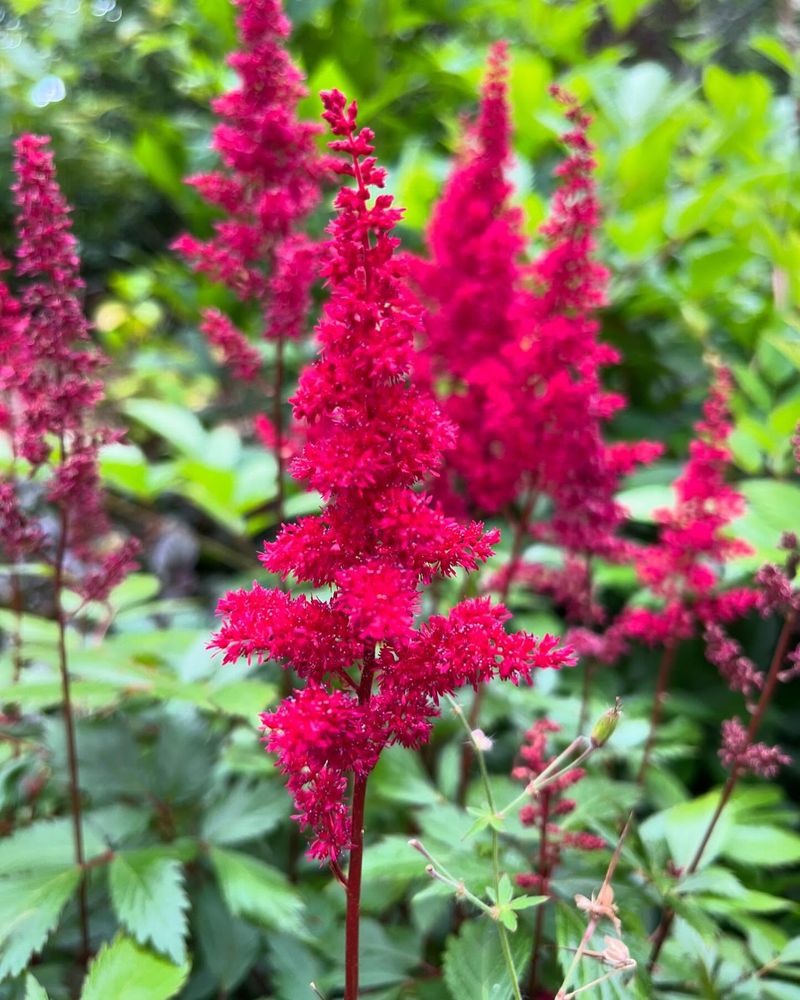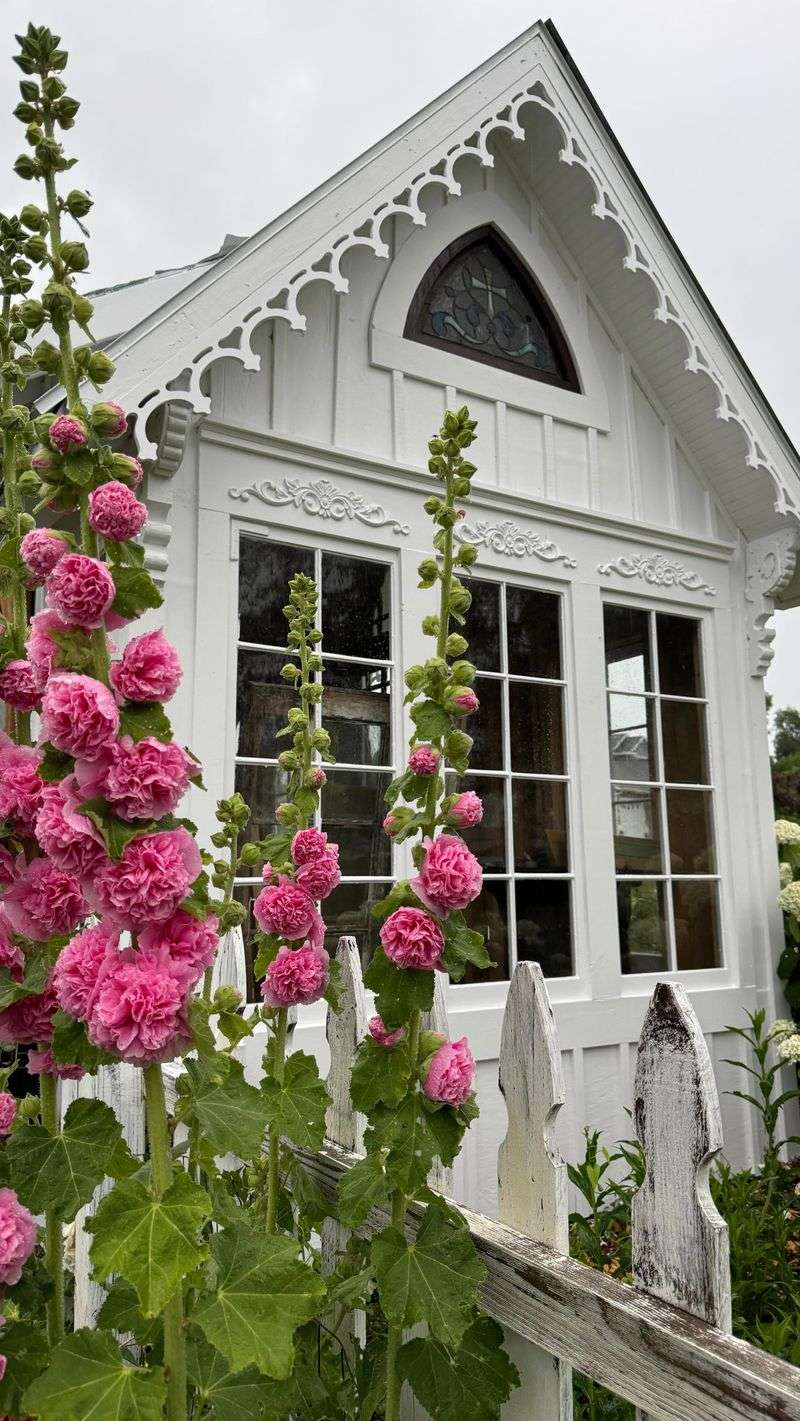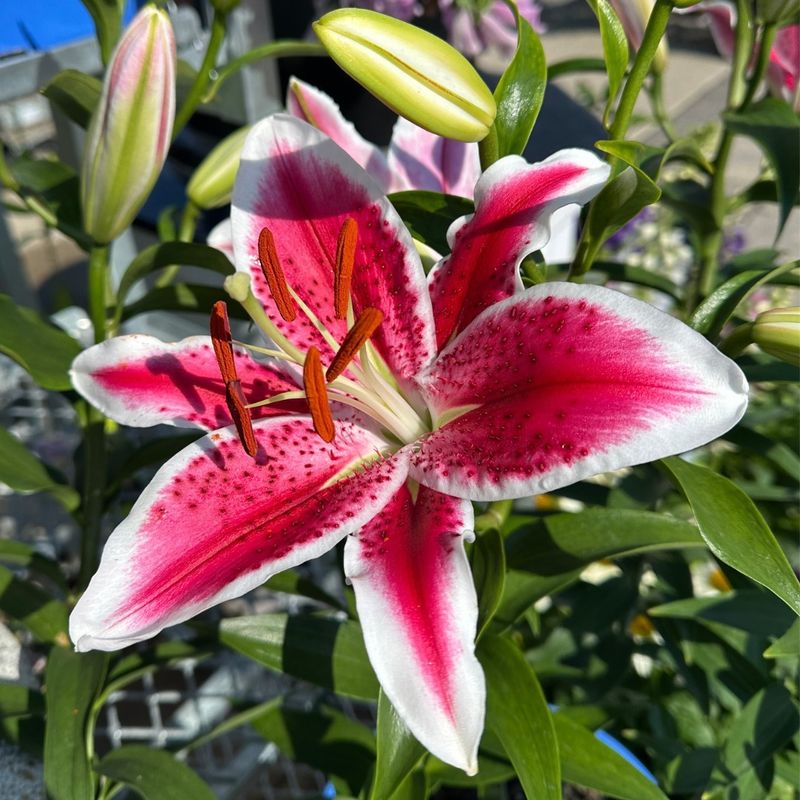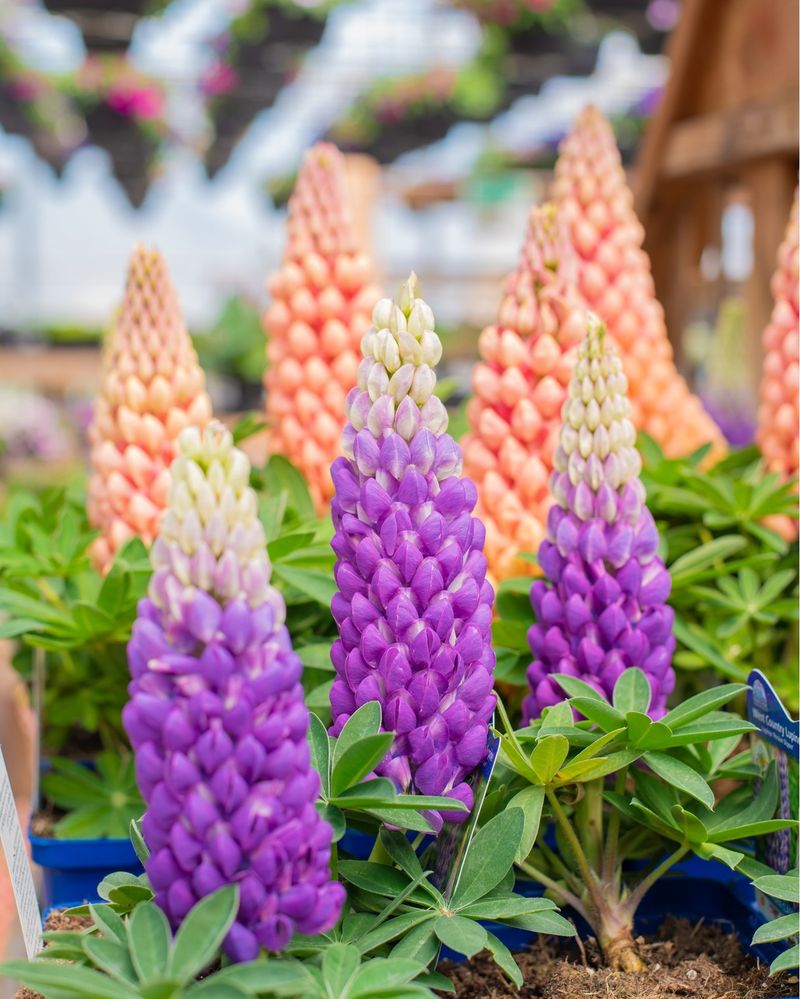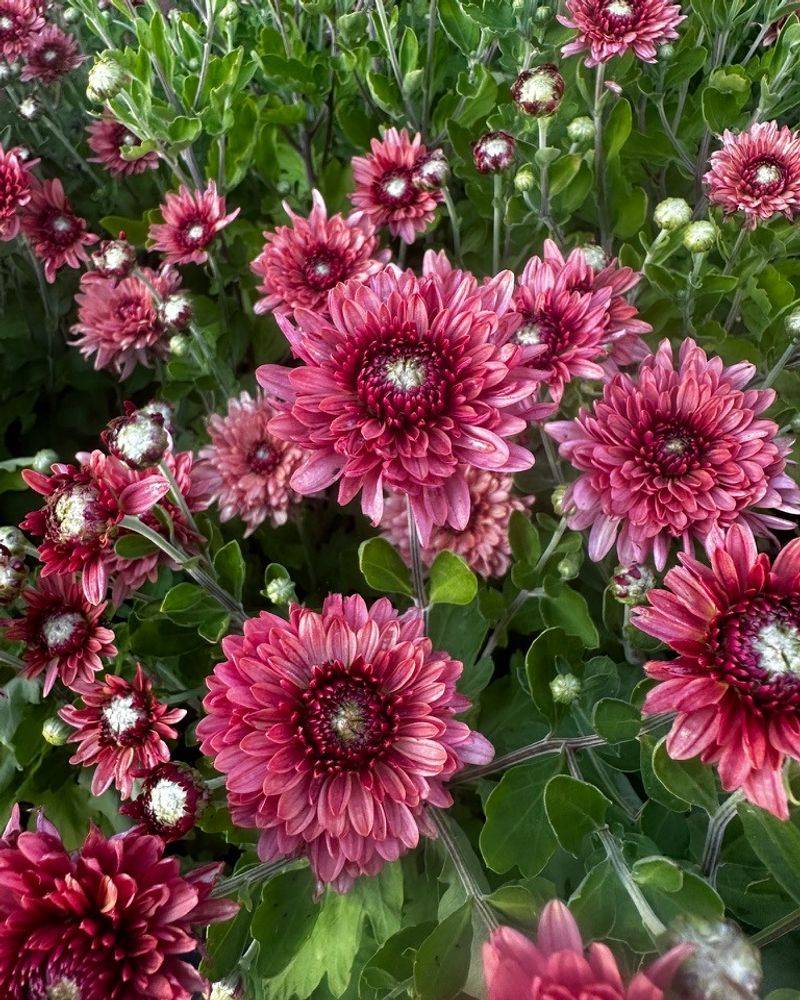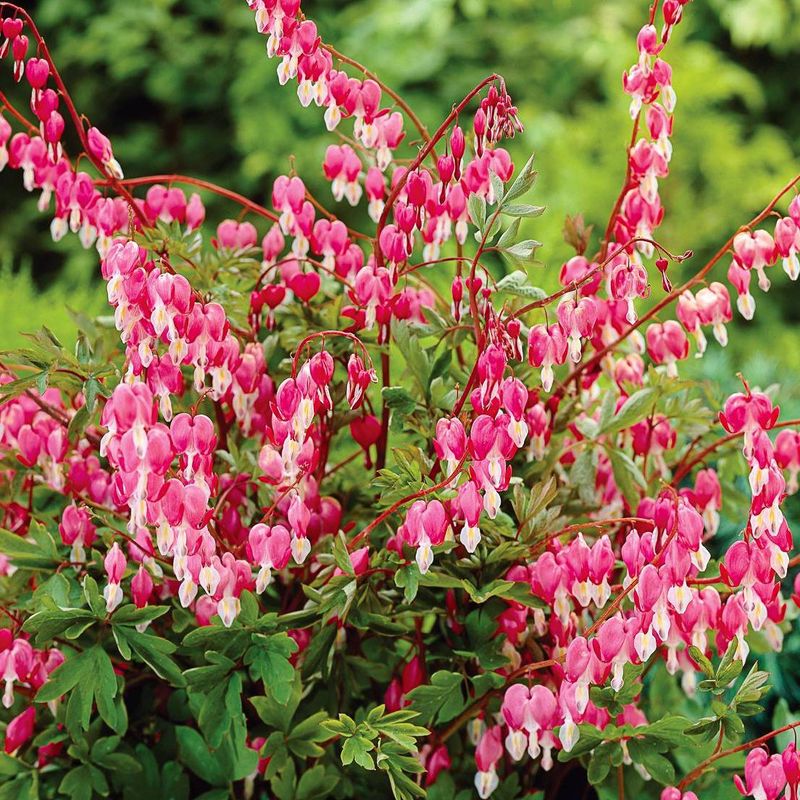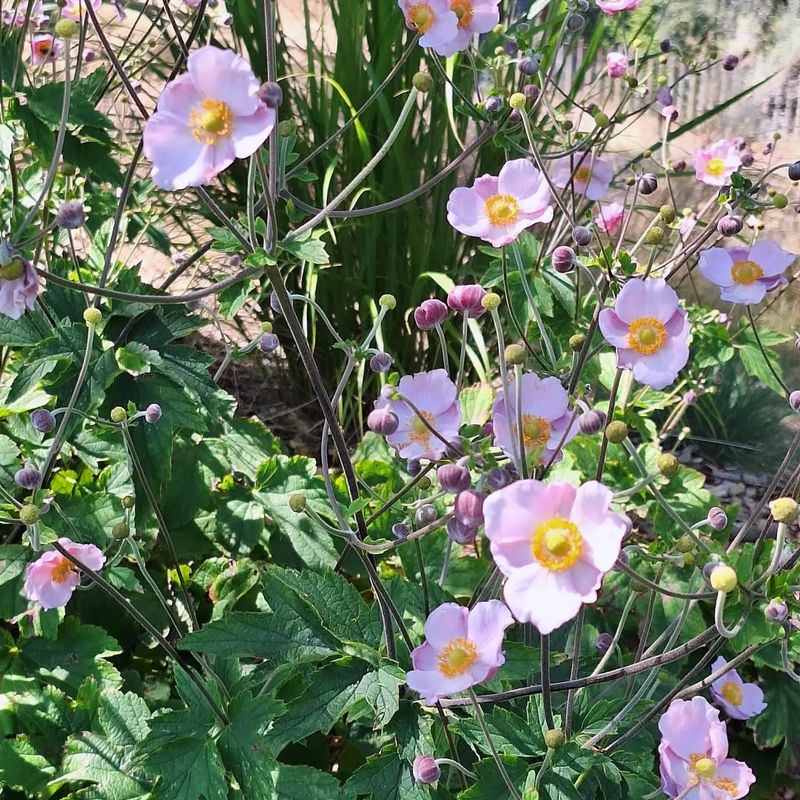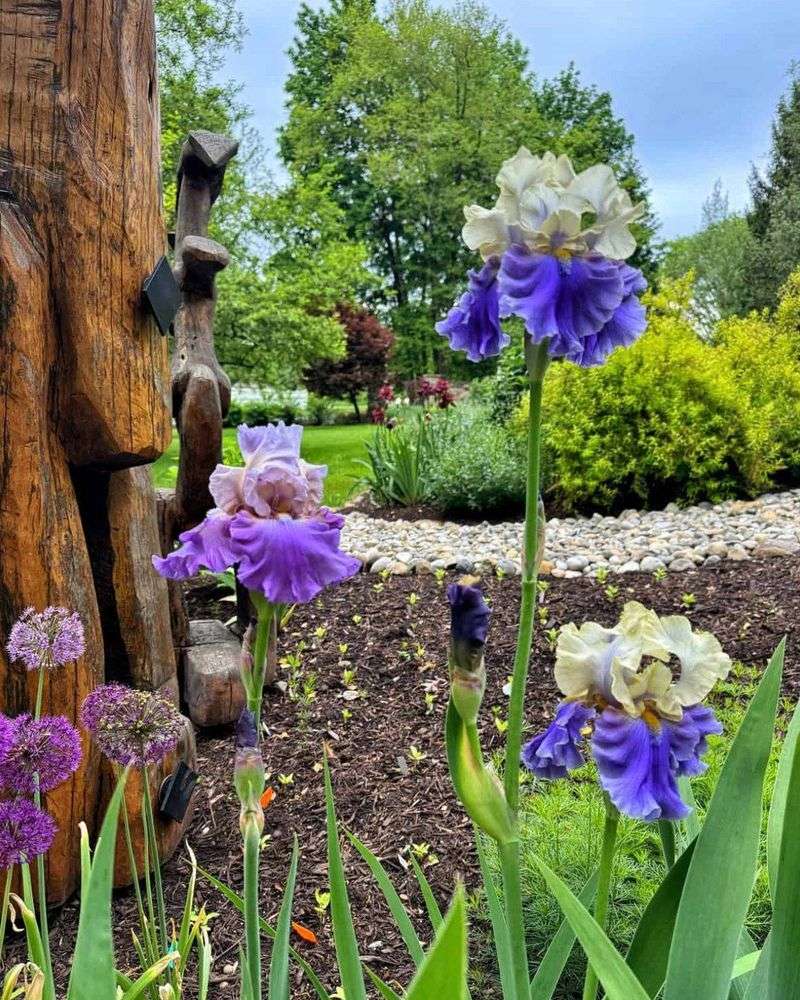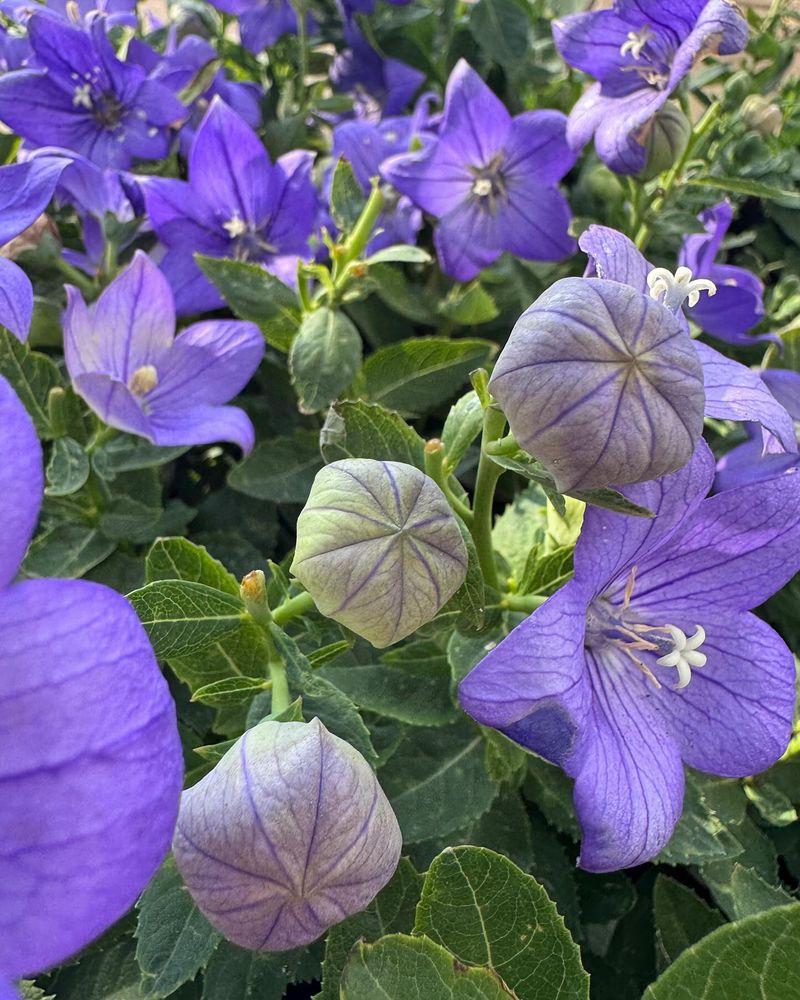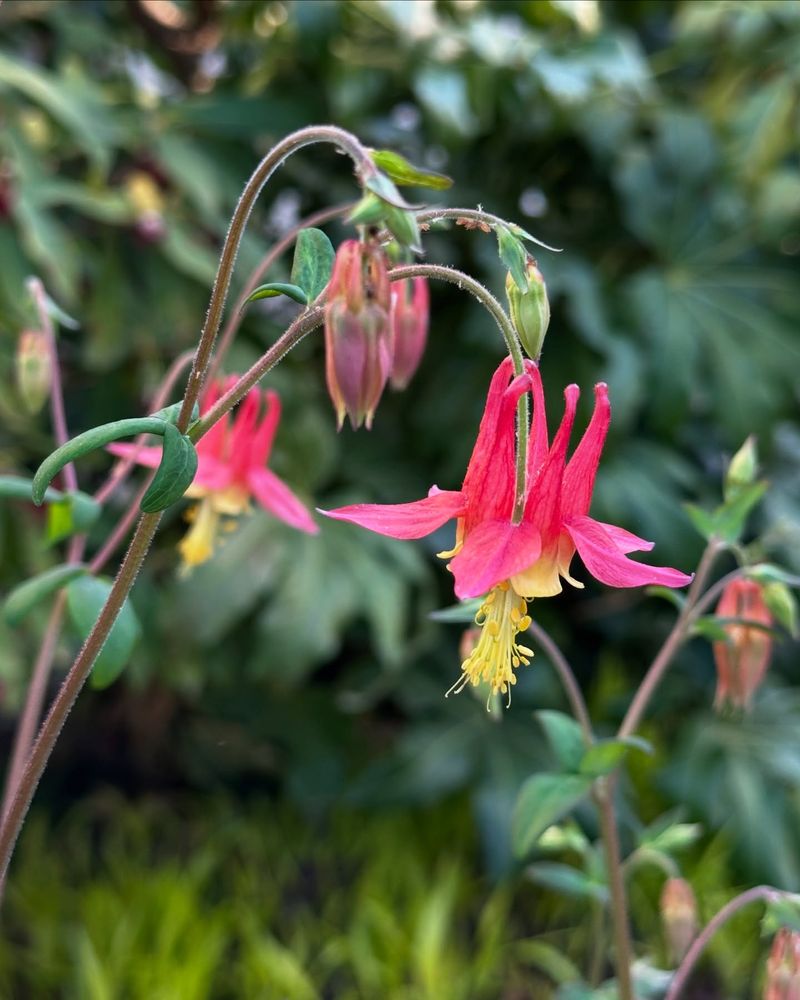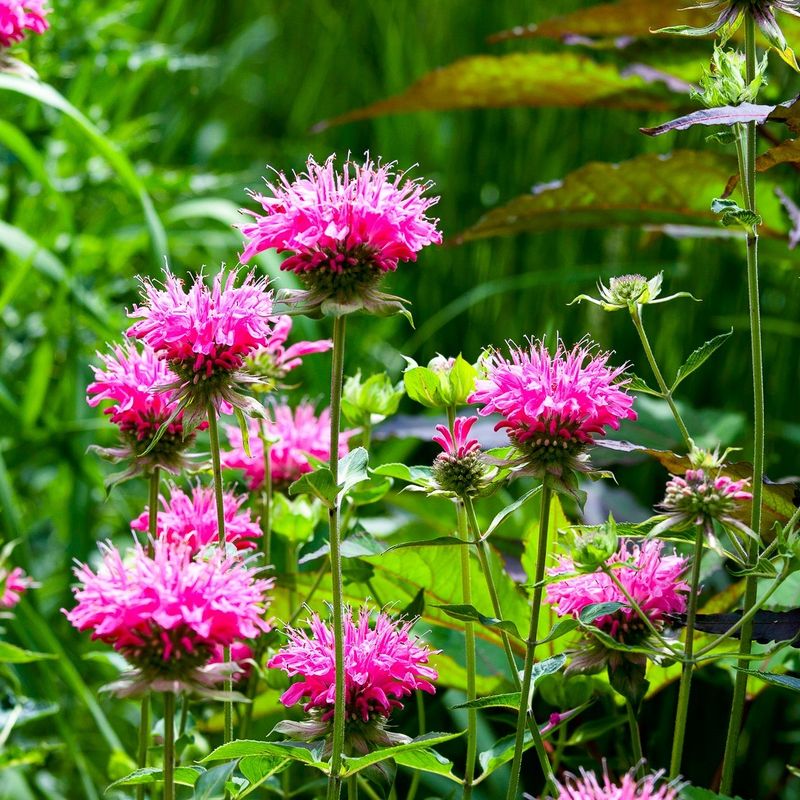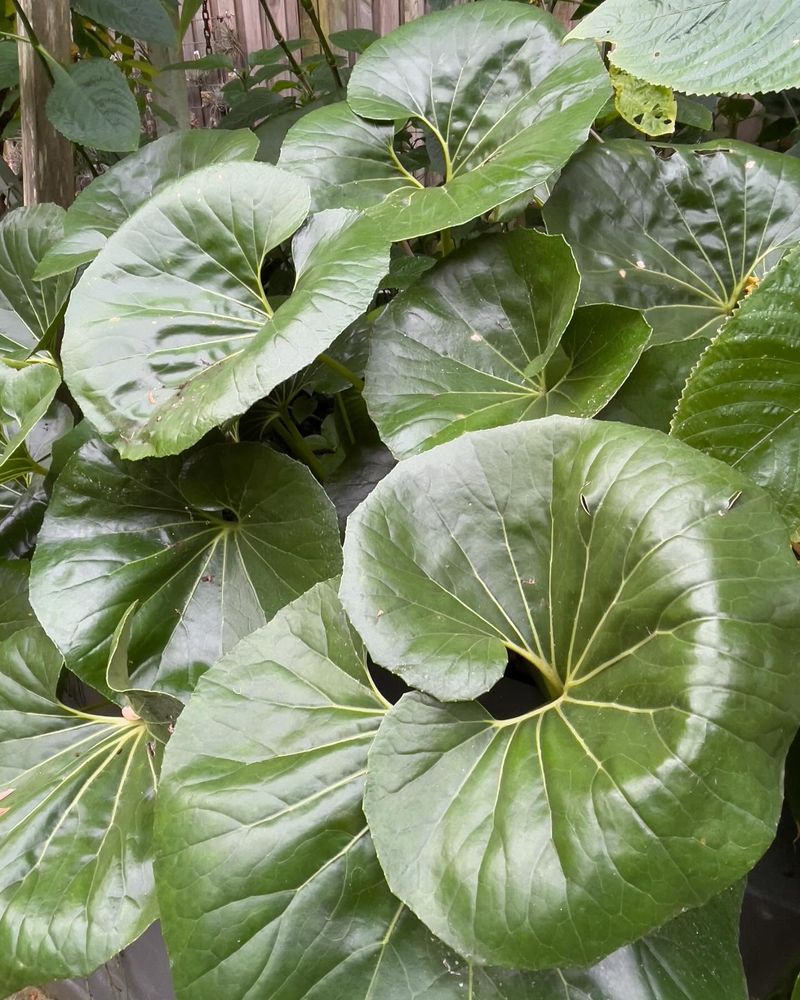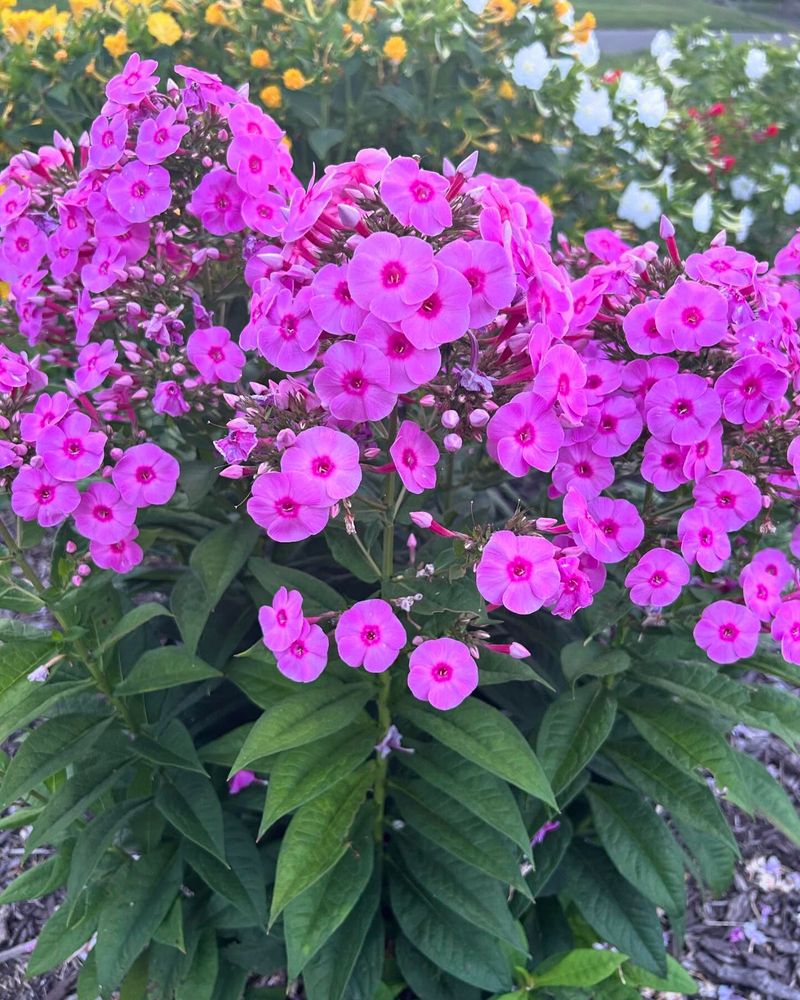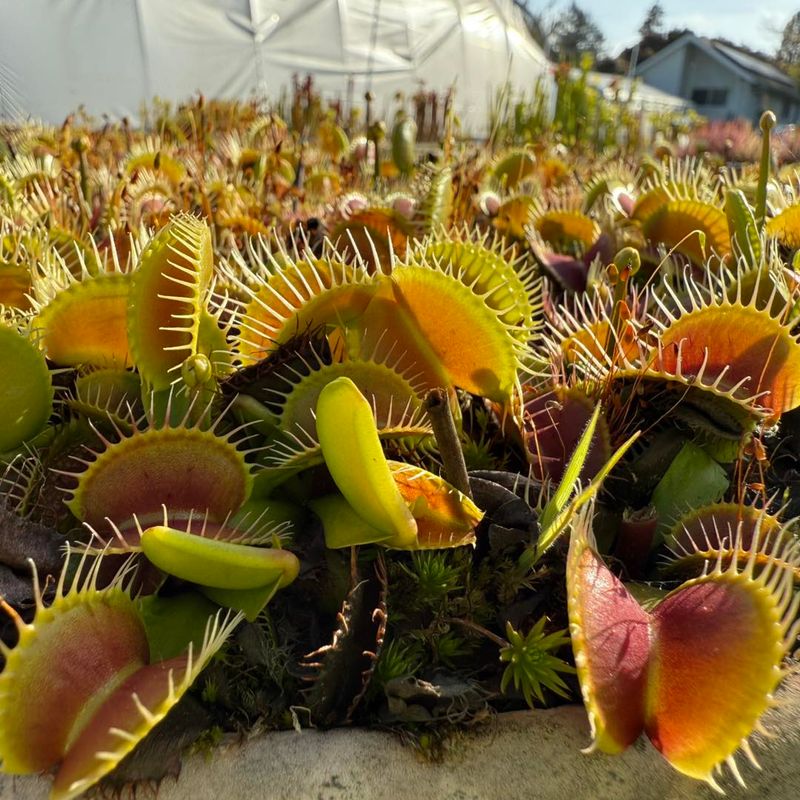I learned the hard way that not all flowers are low-maintenance—some just love the drama. These 20 perennials might look stunning, but keeping them happy can feel like a second job.
They’ll have you watering, pruning, and checking for pests like it’s a daily routine. If you’re into high-maintenance beauty, these might be your kind of challenge. But fair warning: your weekends might disappear into flower duty real fast.
1. Delphiniums
Tall, stately, and absolutely high-maintenance! These stunning blue spires need staking before they even think about blooming, or one summer storm will leave them sprawled across your garden. They’re also magnets for slugs and snails that seem to appear out of nowhere overnight.
Delphiniums demand rich soil, perfect drainage, and regular feeding throughout the growing season. You’ll need to deadhead constantly to encourage more blooms, and even with perfect care, they’re notoriously short-lived. Many gardeners find themselves replanting every few years despite all their efforts.
2. Roses
Everyone loves roses until they actually grow them! These thorny divas require pruning that feels like a surgical procedure – make one wrong cut and you’ll pay for it next season. Black spot, powdery mildew, and aphids will test your patience and your pesticide budget.
You’ll need a calendar just to keep track of their feeding schedule, which changes throughout the growing season. The deadheading never ends, and that’s before mentioning the winter protection needed in colder climates. Even experienced gardeners sometimes throw up their hands at the constant battle against rose diseases.
3. Dahlias
Behind those spectacular dinner-plate blooms lies a plant that demands your undivided attention from spring through fall. Unlike true perennials, these tubers need to be dug up each fall in most climates, carefully cleaned, labeled, and stored in just the right conditions – not too dry, not too damp.
During the growing season, you’ll become intimately familiar with Japanese beetles, which consider dahlias an all-you-can-eat buffet. The taller varieties need constant staking and tying, while all types demand regular deadheading to keep blooming. Water too much or too little, and they’ll punish you with poor performance.
4. Peonies
Those lush, fragrant blooms come with a side of perpetual vigilance! Heavy peony flowers flop over at the slightest rain shower unless you’ve installed support cages early in the season – wait too long and you’ll damage the stems trying to wrangle them into place.
Ants love peonies almost as much as you do, creating a constant parade across your garden. The dense foliage creates perfect hiding spots for fungal diseases, requiring regular inspection and treatment. After flowering, you’re left with large plants that need consistent watering through summer heat, even though their show is long over.
5. Hibiscus
Tropical hibiscus plants are the ultimate garden divas, demanding perfect conditions and throwing tantrums when they don’t get their way. These heat-lovers react dramatically to even slight temperature drops, shedding leaves and buds at the first hint of cool weather.
Insect pests consider hibiscus their personal buffet – spider mites, whiteflies, and aphids will set up permanent residence unless you’re constantly vigilant. The watering schedule is equally demanding – too little and they drop their buds, too much and root rot sets in. You’ll need to fertilize regularly but not excessively, walking a tightrope of plant nutrition.
6. Astilbe
Don’t let those feathery plumes fool you – astilbes are water-guzzling divas that will collapse dramatically at the first sign of drought. Their thirst is never-ending, especially during hot summer months when you might need to water them daily just to keep them from throwing a wilting fit.
The moment conditions aren’t perfect, they develop crispy brown edges that ruin their appearance. After flowering, they demand deadheading to look presentable, but their large, dense foliage makes this a time-consuming task. Dividing them every few years is another backbreaking chore you can look forward to as they quickly outgrow their space.
7. Hollyhocks
Rust is the four-letter word that will haunt your hollyhock dreams! These towering beauties are virtual magnets for this unsightly orange fungus that spreads with alarming speed. You’ll find yourself inspecting the undersides of leaves almost daily during humid weather, desperately trying to stay ahead of the infection.
Staking becomes a structural engineering project as these giants can reach over six feet tall. Despite being short-lived perennials, they self-seed so aggressively you’ll spend hours pulling unwanted seedlings from every corner of your garden. The constant battle against Japanese beetles and sawflies adds another layer of maintenance to these demanding plants.
8. Oriental Lilies
The fragrant blooms come with a price tag of constant vigilance against the dreaded red lily beetle, which can defoliate your prized plants in days. These bright scarlet pests blend perfectly with the stems, making hunting them a time-consuming treasure hunt that never seems to end.
The stunning flowers quickly turn into messy disasters unless you promptly remove the pollen-laden anthers, which stain everything they touch with unmovable orange marks. After flowering, you can’t just cut them back – the foliage needs to be maintained until it yellows naturally to feed the bulbs. Dividing congested clumps every few years is another labor-intensive task that can’t be skipped.
9. Lupines
Those spectacular spires of color mask a plant with diva-like tendencies and a surprisingly short lifespan. Aphids consider lupines their favorite all-you-can-eat buffet, colonizing the stems and buds with remarkable speed and requiring constant monitoring and treatment.
The plants resent hot weather, wilting dramatically during summer heat waves despite your best watering efforts. Their foliage often develops powdery mildew in humid conditions, turning an unsightly white. After flowering, prompt deadheading is essential to prevent aggressive self-seeding that will have you pulling lupine seedlings from every corner of your garden for years to come.
10. Chrysanthemums
Growing show-quality mums is like having a part-time job with strict deadlines! Professional-looking blooms require a rigorous pinching schedule starting in spring and continuing until mid-summer – miss a week and you’ll end up with floppy, sparse plants instead of dense mounds of color.
These fall favorites attract every leaf-munching insect in the neighborhood, from aphids to spider mites. Their shallow root systems demand consistent moisture but hate wet feet, creating a watering balancing act. In colder climates, you’ll need to mulch heavily for winter protection, then divide the plants every spring to maintain vigor – a never-ending cycle of maintenance.
11. Bleeding Hearts
Those charming heart-shaped flowers hide a frustrating secret – they’re summer ghosts! Just when your garden is hitting its stride, bleeding hearts decide to yellow and die back completely, leaving an unsightly gap in your carefully planned border. You’ll need companion plants specifically positioned to hide their disappearing act.
While actively growing, they demand consistently moist soil that never dries out but also never gets soggy. Their delicate stems break easily in wind or under the weight of heavy rain, requiring strategic placement in protected locations. Slugs and snails consider their tender foliage a gourmet meal, necessitating constant vigilance and protection.
12. Japanese Anemones
Don’t be fooled by their delicate appearance – these late-season bloomers have territorial ambitions that would make Alexander the Great proud! Their spreading root system will colonize your entire garden if left unchecked, requiring regular and aggressive division to keep them in bounds.
Establishing them is an exercise in patience and perfect conditions – too much sun scorches them, too little and they won’t bloom. Finding that sweet spot of dappled shade with moist but well-drained soil feels like garden alchemy. Once established, they’re prone to leaf spot diseases that require prompt removal of affected foliage before the problem spreads throughout your garden.
13. Bearded Iris
The iris borer is just the beginning of your maintenance nightmare with these classic perennials! These destructive caterpillars tunnel through rhizomes, requiring vigilant inspection and immediate action at the first sign of trouble. The rhizomes themselves demand to be planted with their tops exposed, creating perfect hiding spots for all manner of garden pests.
After flowering, the foliage often becomes unsightly but can’t be removed until fall. Division is mandatory every 3-4 years, involving digging, cleaning, inspecting, and replanting the entire clump – a back-breaking task in the heat of summer when it needs to be done. Soft rot and leaf spot diseases add another layer of required vigilance.
14. Balloon Flowers
Those charming balloon-like buds come with a support system requirement that rivals helicopter parenting! Without staking, these top-heavy perennials will flop in every direction after the slightest rain, creating a messy tangle instead of an upright display.
Their late emergence in spring creates a different problem – you’ll need to mark their location carefully or risk accidentally digging up the dormant crowns while planting spring annuals. Slugs consider their tender new growth a delicacy, requiring constant monitoring. The plants resent being moved or divided, responding to such disturbances by sulking for an entire growing season or simply failing to return the following year.
15. Columbines
Leaf miners will turn your columbine foliage into an unsightly mess of squiggly white trails faster than you can say “high maintenance”! These persistent pests require immediate removal of affected leaves, sometimes leaving you with barely any foliage by mid-season.
While they self-seed enthusiastically, the resulting offspring rarely resemble their parents, quickly reverting to less interesting forms and colors. Powdery mildew loves their foliage during humid summer weather, requiring preventative treatments. Their relatively short lifespan means you’ll be constantly replanting to maintain your display, as most plants begin to decline after just 3-4 years despite your best efforts.
16. Monarda
Powdery mildew is the sworn enemy of bee balm, turning the foliage an unsightly white just as the flowers reach their peak! This fungal disease spreads rapidly during humid weather, requiring constant monitoring and immediate removal of affected leaves – a never-ending battle throughout summer.
The plants spread aggressively through underground rhizomes, quickly escaping their designated space and invading neighboring plants. Division becomes mandatory every 2-3 years to maintain vigor and control their territorial ambitions. The hollow stems are prone to breakage in wind or rain, creating a constant tidying task. Deer resistance is their one saving grace among many maintenance headaches.
17. Crocosmia
These fiery orange bloomers multiply underground with alarming speed, turning from a modest clump into a garden takeover faster than you can say “maintenance nightmare”! Their sword-like foliage forms dense masses that require regular division – ignore this task and you’ll soon find flowering performance declining as the corms compete for resources.
The tall flower stalks demand staking in all but the most sheltered locations, otherwise, they’ll sprawl in every direction after summer storms. In colder climates, they require winter mulching to survive, then careful spring cleanup to prevent rot. Their bright flowers attract hummingbirds and every garden pest imaginable, creating a constant monitoring requirement throughout the growing season.
18. Ligularia
Slugs and snails consider the large, succulent leaves of ligularia to be an all-you-can-eat buffet! You’ll need to patrol with flashlight in hand during evening hours to keep these pests from turning your prized foliage into Swiss cheese overnight.
Despite needing consistently moist soil, these drama queens will collapse into a wilted heap at the first hint of drought, even if the soil just a few inches down remains damp. Their water demands make them incompatible with most other perennials, creating planting challenges. The large leaves act as solar collectors, scorching easily in direct sun and requiring strategic placement in the garden to prevent constant leaf damage.
19. Phlox
Powdery mildew doesn’t just visit tall garden phlox – it takes up permanent residence! This fungal nightmare turns the lower leaves white, then brown, steadily working its way up the stems until your plants look like they’re wearing disease socks by mid-summer.
Preventing this requires religious spacing for air circulation, sometimes meaning fewer plants than you’d like. Deadheading is essential to prevent rampant self-seeding that results in less desirable offspring reverting to magenta colors. Spider mites adore the undersides of phlox leaves during hot, dry spells, requiring regular inspection with a magnifying glass to catch infestations early before they cause irreversible damage.
20. Carnivorous Plants
Venus flytraps and pitcher plants turn the tables on garden pests but demand more specialized care than a newborn baby! These bog-dwellers require distilled or rainwater exclusively – tap water’s minerals will slowly kill them, meaning you’ll need a separate watering system just for these prima donnas.
Their growing medium can’t contain regular soil or fertilizer, necessitating special mixes of peat moss and perlite. Humidity requirements mean most need terrarium-like conditions, creating a maintenance regimen entirely different from your other perennials. Dormancy periods must be carefully managed with specific temperature and light reductions, turning your growing area into a climate-controlled science experiment.

